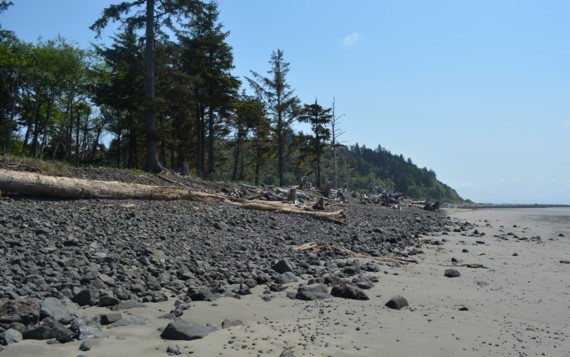Community Leadership Paves the Way to Promising Erosion Treatment
The Takeaway: A project that mimics aspects of cobble sand beaches virtually stopped the erosion of shoreline uplands in pilot studies aided by NOAA and Washington State’s coastal zone management program.

In Washington State, the Shoalwater Bay Tribe, local government, and the North Cove community led a vigorous local effort to find effective treatments for severe shoreline erosion, flooding, and sea level rise along Willapa Bay. Their determination is starting to pay off in pilot projects that are halting erosion in its tracks via rebuilt dunes and the placement of cobble berms—called “dynamic revetments”—along the shoreline. The partners also are restoring natural buffers to reduce hazard impacts. The Washington Coastal Zone Management Program provided award-winning technical and monitoring assistance and worked to secure grants, one supported by NOAA’s Office for Coastal Management.
The revetments’ combination of fine beach sand and cobble—which includes pea gravel to stones and midsize rocks—moves with the waves but takes much energy from them. This design is comparatively low cost, simple to construct, and hardy. After a heavy winter storm season, researchers discovered that the pilot area showed little to no retreat of shoreline uplands, while nearby untreated areas lost tens of feet. The revetment even helped the beach accumulate extra sand in some spots.
In an area where coastal land loss has averaged as much as 100 feet per year, the project has proven benefits. On one 3,000-foot stretch, the width of the dune area grew seven-fold in six years–the accumulation of more than 232,000 cubic yards of sand. The project has been so successful, it was recognized by the American Shore and Beach Preservation Association as one of the nation’s best restored beaches.
The Shorelands and Environmental Assistance Program, home to the state’s coastal zone management program, won a Washington Department of Ecology award for its role in supporting the pilot programs.
Local investors have also supported the project. Hopes are now high to expand these promising results along more shorelines, with different partners variously pursuing aid from state, federal, nonprofit, or private funds. Their success could be critical to preserving the quality of life treasured by local residents.
Success would:
- Ensure the safety of local businesses and health clinics near shoreline areas
- Save large areas of tribal habitat for subsistence shellfish growing and harvesting
- Preserve up to 816 acres of cranberry crops, representing more than half of all Washington cranberry growers
- Retain the structural soundness of the fastest local route for tsunami evacuation and emergency responders, residents, businesses, and tourists
Community engagement is at the heart of these successful pilot findings. North Cove and tribal members helped design pilot studies, held community work parties to drill rocks and place monitoring trackers, set up photo tracking at the site, and played other critical roles.
Pacific County, the North Cove community, and the Shoalwater Bay Indian Tribe formed the Willapa Erosion Control Alliance Now to bring together private, nonprofit, and agency partners on this effort. (2020, Updated 2024)
Partners: Friends of North Cove, Grayland Drainage District 1, Mott MacDonald, North Willapa Harbor Grange 947, Ocean Spray Cranberry Growers, Oregon State University, Pacific Conservation District, Pacific County, Shoalwater Bay Indian Tribe, Washington Sea Grant, U.S. Army Corps of Engineers, U.S. Fish and Wildlife Service, Washington State Department of Archeology and Historic Preservation, Department of Ecology’s Coastal Zone Management Program, Department of Fish and Wildlife, Department of Natural Resources, Department of Transportation, Emergency Management Division, Office of the Governor’s Coastal Marine Advisory Council, and Parks and Recreation Commission
PRINT